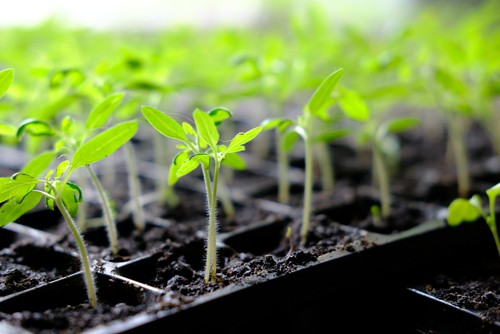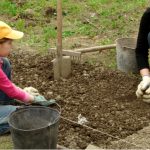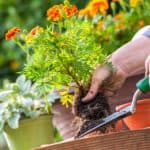Last updated on March 22nd, 2022
Our site is reader supported, this means we may earn a small commission from Amazon and other affiliates when you buy through links on our site.
Now that April is upon you and spring is legitimately in the air, it’s time to focus on weed control, starting with your lawn and sowing seeds indoors.
Jobs to do in April
- Scarify and aerate your lawn to remove moss, thatches and weeds.
- Start cutting the lawn again, start high and reduce gradually.
- Start weeding beds, borders as well as driveways and paths to control weeds early. Do this manually or with weedkillers.
- Sow tomatoes, cucumbers and other vegetables indoors.
- Sow sweet peas indoors.
- Sow salads, beetroot and annual herbs if the ground is above 6°C.
- Start sowing half-hardy annuals and summer bedding indoors.
- Plant seed potatoes, shallots and onions.
- Feed roses as they burst into growth to give them the best start and help fight off diseases.
- If you have forced some Rhubarb (as we recommend by covering with buckets) pick what you need and remove buckets to allow the Rhubarb to grow naturally with light again.
- Continue watching out for Lily beetles and remove them.
- Protect fruit blooms from frost damage with fleece.
- Tie in climbing and rambling roses.
- Now the right time to start feeding citrus plants.
- Sow new lawns or repair dead lawn patches.
- Prune fig trees.
- Divide bamboo plants – learn how to in this guide.
Lawn Care
First of all, lawn care is imperative during the month of April. As the weather stays warmer it’s time to repair the damage brought about by a winter of neglect. At this point, you should begin mowing your lawn at least once a week. Make sure to place your blades at the highest setting and then slowly lower them over subsequent weeks rather than starting with the lowest setting. This will help prevent shock for the grass and give an opportunity to come to terms with regular maintenance once again.
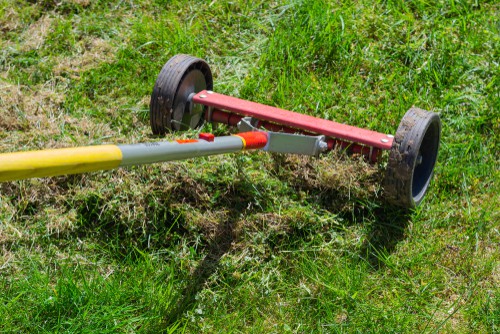
Have you considered a cordless lawnmower? You can see our top recommended models here.
Use a strimmer to produce that manicured finish on the lawn as well. If you notice any weeds or moss it’s time to treat your lawn. This is something you can do with a process called scarifying and aerating, and it naturally removes the clumps of moss, dead grass, thatch, and other debris that may have accumulated over the winter. You can use a moss killer or weedkiller treatment afterward.
Learn how to scarify your lawn to remove moss and thatch in this guide
Learn how to aerate your lawn to improve drainage in this guide
Weed Control
On that note, it’s time to get rid of weeds sooner rather than later. You don’t want the weeds to mature, seed, and become severely problematic if you can avoid it. So, start tackling your weeds by hoeing your garden at least once a week. If you have a problem with perennial weeds like dandelions, you should apply a weedkiller that includes glyphosate to remove them permanently if you are treating paths and drives. Use a specialist lawn weedkiller for lawns to avoid killing your lawn or use a weed puller to remove weeds from lawns.
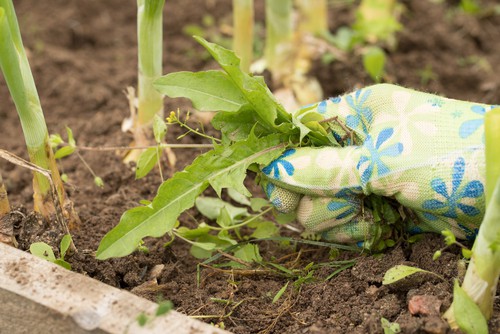
Sweet Peas
You should head out into the garden and start planting your sweet peas with some form of climbing support around which their tendrils can wrap. You might need string or other gardening hooks to secure your sweet peas to the posts, stakes, or trellises you install.
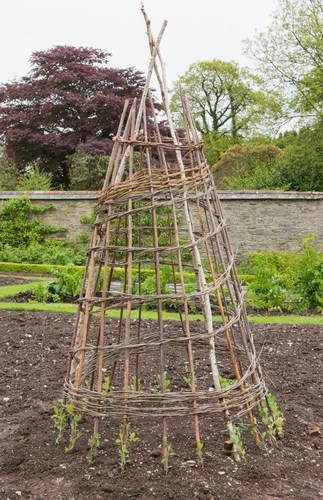
Read our guide on growing sweet peas for more information
Salads
If you planted any type of salad earlier in the season it might be time to pick them now. It’s better to cut off the leaves as you eat them rather than pulling out the entire head of lettuce if you can avoid it. The reason for this is that leaving the head in the ground and only picking off what you need will force the plan to continue resprouting new leaves to replace the ones you have consumed. This will extend the lifespan of the lettuce and your enjoyment of fresh salads.
Mustard lettuce, loose-leaf lettuce, and rocket lettuce are some of the easiest to cultivate.
Sow more Vegetables
But that’s not all you should cultivate. In the middle of April, it’s time to start sowing most of your vegetables. You can plant onions directly in the ground as well as potatoes which include earlies, second earlies and maincrop. If you haven’t already you can start your tomatoes indoors and move them outdoors a little bit later in the year when the risk of frost has passed, this is usually around May. You can also start your cucumbers inside. Outside, of course, you can plant celery, basil, leaf beet, sweetcorn and squash.
